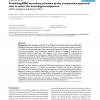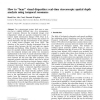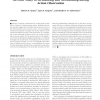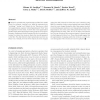26354 search results - page 169 / 5271 » How we refactor, and how we know it |
BMCBI
2007
13 years 10 months ago
2007
Background: The secondary structure of an RNA must be known before the relationship between its structure and function can be determined. One way to predict the secondary structur...
BMCBI
2007
13 years 10 months ago
2007
Background: The search for enriched features has become widely used to characterize a set of genes or proteins. A key aspect of this technique is its ability to identify correlati...
BC
1998
13 years 10 months ago
1998
Abstract. In a stereoscopic system, both eyes or cameras have a slightly dierent view. As a consequence, small variations between the projected images exist (`disparities') ...
JOCN
2011
13 years 1 months ago
2011
■ Humans commonly understand the unobservable mental states of others by observing their actions. Embodied simulation theories suggest that this ability may be based in areas of...
JOCN
2011
13 years 1 months ago
2011
■ Observers spontaneously segment larger activities into smaller events. For example, “washing a car” might be segmented into “scrubbing,” “rinsing,” and “drying�...




